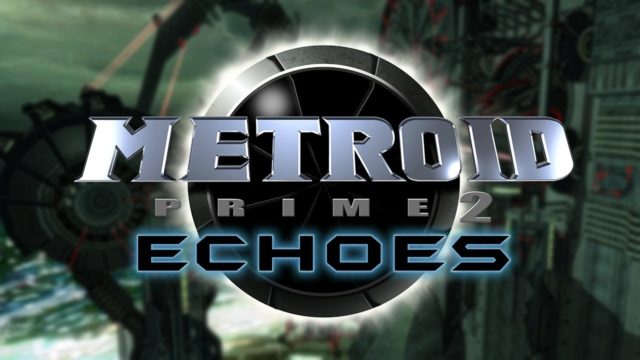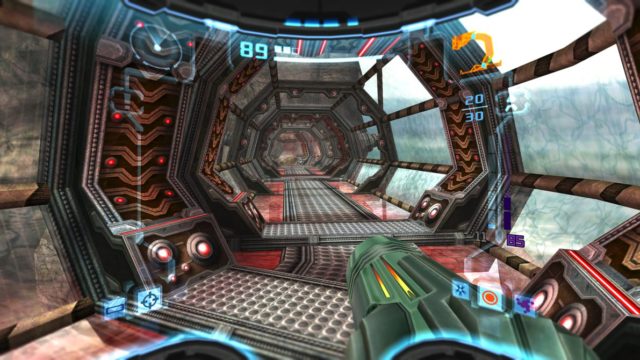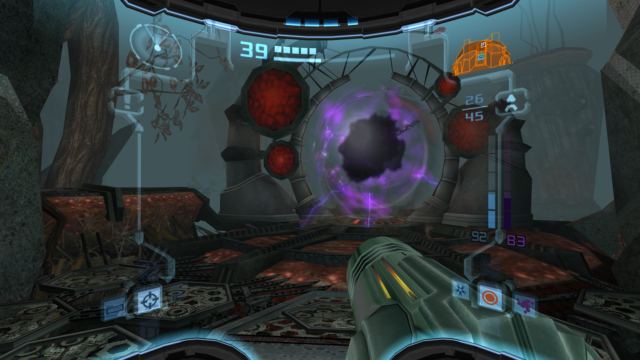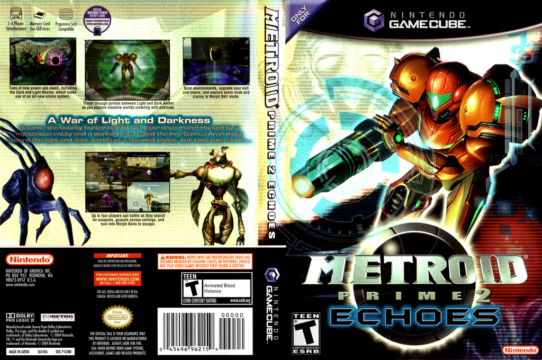
Welcome to our first Retro Scope Deluxe! It’s the same insight and commentary you love, but supersized! It’s more content and more analysis for your reading pleasure. For this inaugural installment, Robert takes a deep dive into the GameCube classic Metroid Prime 2!
In November of 2004, I would’ve been right at the tail end of my first quarter of college. That’s when Metroid Prime 2: Echoes launched, and in the fourteen years since then I’ve always wondered why, of the three titles in the series, this game never gripped me in the same way as its brethren. I played the hell out of the original Metroid Prime when it first released, as well as Metroid Prime 3: Corruption, but Metroid Prime 2 was different. I couldn’t sustain long play sessions with the game and, for the life of me, I could never figure out why. Until now, that is.
There were rumors for years (and still are in some circles) that Nintendo has been toiling away on a secret project called “Metroid Dread.” I’m here to tell you that the truth is that we’ve been playing Metroid Dread all this time— they just decided to name it Metroid Prime 2, instead. I’m joking, in part, but the reality is that until this past weekend, I never realized what a sense of dread that Metroid Prime 2 elicits. There is a palpable darkness that permeates this game, both thematically and visually. It fostered a feeling of fear and apprehension in me that I’ve never appreciated until now.
The game is set on the planet Aether. The Luminoth, a race of interstellar beings not unlike the Chozo, had adopted the planet as their home world before a cataclysmic Phazon meteorite impacted Aether and put it into a state of interdimensional flux. Now, Aether shared the same timespace as its new twisted mirror, Dark Aether, putting a drastic strain on the two planets and their inhabitants.
Aether became a wasteland while Dark Aether flourished in the chaos, breeding a race of craven monsters that the Luminoth would eventually name the Ing, which in their language stood for “terror.” The Luminoth and Ing would go to war over the planet’s energy, with the former nearly wiped out by the latter. Eventually, a lone Luminoth named U-Mos became the caretaker of his remaining people who laid in stasis, waiting for a champion to come restore order and peace.

That champion would of course be Samus, who comes to Aether when the Galactic Federation loses a squadron of soldiers on the planet’s surface. Samus’ Gunship is damaged as it enters Aether’s atmosphere, which sends her careening down below its heavily cloud-pocked skies. Samus emerges from her Gunship glistening in her Varia Suit, leaping to the ground and ready to enter the fray. It’s right from this moment that Metroid Prime 2 starts to establish its morose atmosphere.
The opening arc of the narrative sees Samus winding her way through the various caves and corridors that surround her landing site in search of the missing marines. What greets her is an unrelenting stream of dead bodies. The soldiers have all been slaughtered by the Ing in a variety of disturbing ways. Eviscerated, bludgeoned, shot by friendly fire— the full gamut of awful ways that a soldier could (theoretically) die on an alien world filled with bloodthirsty predators are relayed to Samus as she scans their fallen forms.

Playing in the background is composer Kenji Yamamoto’s bleak-yet-stirring score. There’s a bass-line used here that’s very similar to the one that can be heard throughout the first Terminator movie; it sweeps through almost every track in the game in one form or another and serves to create a near-constant sense of tension. There are some callbacks to the more adventurous tunes of Metroid Prime, particularly in the Torvus Bog and Sanctuary Fortress, but overall Metroid Prime 2‘s score leans much more heavily towards the somber than the jaunty in terms of tone. Yamamoto’s bass-laden, grim soundtrack is constantly pulsing and accentuating the feeling of fear in tandem with the environments themselves.
Aesthetically, the design team at Retro Studios did everything it could to reinforce and communicate the bleak atmosphere of Metroid Prime 2. One of the earliest sights in the game is of Federation troopers dangling from the ceiling of a cavern being feasted on by the spider-like Splinter creatures. Death surrounds Samus as she makes her way across Aether. Fallen Federation and Luminoth soldiers are sprinkled around every inch of the planet like macabre signposts, posthumously conveying their various pieces of the story and sometimes giving Samus a hint where to head next.

The environment itself, meanwhile, acts as the perfect backdrop to all this carnage. Organic and man-made forms are juxtaposed everywhere— vines and trunks are interwoven with metal and lights, plates of steel jut from outcroppings of rock, and so on. Yet, as much of a visual cornucopia as this is to behold, it’s nonetheless foreboding. The player is compelled to proceed, but there’s so much to be wary of that it can be tough to move forward. The world feels harsher than Tallon IV ever did, with dangers around practically every corner. The foes are not only monstrous, they’re also brutally tough. Which is to say nothing of the Ing and their home, Dark Aether.
The game is roughly split between time on Aether and Dark Aether. While the latter is essentially supposed to be an eerie mirror of the former, Dark Aether is a veritable hellscape by comparison. The world there is somehow harsher, with garish colors filling the sky and Ing-possessed versions of Aether’s stock of enemies haunting every corner. The Ing themselves are amorphous monsters comprised of jagged edges and searing, red eyes. They’re merciless, horrifying, and lurk everywhere. While the sense of dread on Aether is nothing to sneeze at, on Dark Aether it reaches new heights.

A major reason that Dark Aether is so much more oppressive is because of how claustrophobic it feels. As the name so aptly states, the world of Dark Aether is draped in shadow. The atmosphere is also toxic to Samus, with her only respite coming from the spheres of light emitted from special crystals that were installed by the Luminoth. The light shields Samus from harm, but being restricted to these small pools of safety makes trips to Dark Aether feel very confining. What’s more, the Ing will often surround the bubbles of light, further compounding the sense of being hemmed in on Dark Aether.
The result of all this meticulous design work is, again, a world to be dreaded. While things let up a bit in the third act when Samus ventures to the Sanctuary Fortress, even there the game world is still fraught with hazards and unknown threats. I’ve played countless “scary” titles like Resident Evil, Dead Space, and others, but Metroid Prime 2 chills from a psychological front. It relentlessly beats on the player, demanding that they cast aside doubt and fear in order to move deeper into Aether and discover its secrets. Incidentally, this need to swallow down the fear and march ahead is a great parallel to what Samus does in every game.
It’s this assault of sound, music, and atmosphere that made it so hard for me to casually play Metroid Prime 2 the way that I have the other two Prime installments. Yet, in returning to the game, I’ve come to find that this dark, threatening vibe is why I haven’t been able to stop playing it this time around. It’s violent without being gory. It’s dark without being melancholy. It has the usual Nintendo magic that the Metroid franchise is renowned for while also distancing itself from the more kid-friendly brand of “all ages” that the company is known for. Metroid Prime 2‘s unique atmosphere makes it debatably the most sophisticated feeling game in the series.
Now that we’ve broken down the game’s atmosphere, let’s see how else Metroid Prime 2 differentiates itself from its predecessor!




 ShareThis
ShareThis





